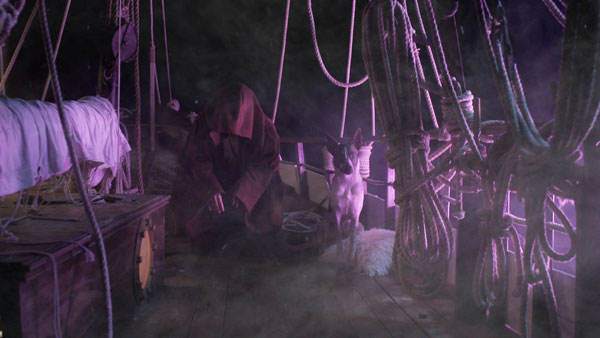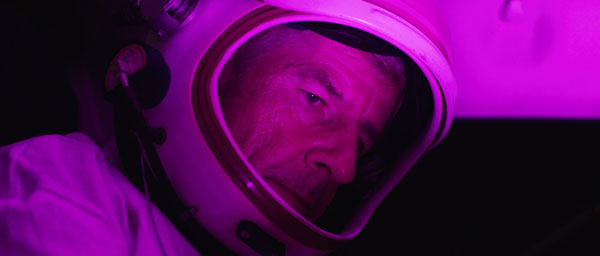Film and video artist Christopher Richmond has been interested in science fiction for as long as he can remember. When he was a kid, he rented videos based solely on the cover art; his favorites were sci-fi. “Any sort of surrealist landscape, I was sold,” he tells me during a conversation at his studio near MacArthur Park on a hot summer-like day in February. He was also fascinated by comic books and “obsessed with notions of world-building,” he says, for which “science fiction is the inherent laboratory.”
The 32-year-old artist has been making film and video art that fits roughly into the science-fiction genre for nearly a decade. His newest project, Hyperway, a three-channel philosophical science-fiction-styled road trip film that comes in at nearly 100 minutes, opens at Moskowitz Bayse in November for his second solo exhibition at the gallery. The film might be about space travel to another world, or it might also just be a film about a trip into the Mojave Desert. The title reflects Richmond’s depiction of the freeway as an intergalactic roadway—a “Hyperway.” Shot entirely on Southern California freeways and locales without elaborate staging or effects, it derives its otherworldliness from costuming, monologues and the audience’s willing suspension of disbelief, and reprises Richmond’s favored elements: hand-made, cartoonish costumes; familiar locations beset with a sense of surreal displacement; a discontinuous narrative; philosophical discourse; a sense of foreboding; and for good measure, two different taxidermy coyotes.

Production stills from Hyperway, 2018, all images courtesy of artist and Moskowitz Bayse, Los Angeles.
Tall and slender with a crown of unruly curls, Richmond is energetic and loquacious, often stopping mid-thought and starting over. I saw his films for the first time two years ago at his debut solo exhibition, “Double Fantasy,” at Moskowitz Bayse. Panthalassa (2015), a two-channel, 49-minute HD video, was a hallucinatory mind game in which Richmond played the main character. Stranded on a sailing vessel that is lost on an endless sea, he is hectored by a chimeric presence. Rendezvous (2016), a single-channel 41-minute HD video (and 16mm color film, VHS and sound transferred to HD) involves a mysterious event, an asteroid, a stranded alien and a character (Richmond) who seems to take the pulse of the solar system as he wanders around Los Angeles with a microphone aimed at the sky.

Christopher Richmond, Panthalassa, 2015 (still), courtesy of the artist and Moskowitz Bayse, Los Angeles.
Richmond studied cinematography as an undergraduate at Chapman University, where he learned all he ever wanted to know about narrative and three-act structure. While satisfying liberal arts requirements, he was exposed to contemporary photography and conceptual art. Richmond quickly began to develop his own practice, which afforded him opportunities to explore ideas in ways that his film program did not.
He elected to pursue an MFA because he wasn’t interested in telling stories; rather, he “wanted to explore the fissure between story and discourse.” The willing suspension of disbelief was “just as curious as our desire to make order out of chaos,” he says. And a master’s degree at a film school wasn’t the place to do this. He wanted to study with other artists, especially those who weren’t working with film or video.
“My work didn’t really start off as science fiction,” he says, though as early as 2009 his films explore the genre. And as he neared the end of graduate school, he increasingly focused his practice on world-building. Comic books are a major influence. “I try to follow closely the storylines that grapple with comic book continuity,” he says; between crossovers, tie-ins and spin-offs, a changing roster of writers, and “simultaneous storylines about the same character, differentiated by nothing more than words like ‘spectacular,’ ‘uncanny’ and ‘amazing,’ it is unlike anything else. It’s no wonder every decade or so, the big comic book companies do spring cleaning and end the world or destroy reality. I love this about comic books.”

Production stills from Hyperway, 2018, all images courtesy of artist and Moskowitz Bayse, Los Angeles.
Then there’s his fascination with theoretical physics, which presents possibilities of the multiverse, wormholes, and other speculative thought experiments. At an early age, he thought he would become an astrophysicist. His grandfather was a graduate of Caltech and a civil engineer. His uncle worked for NASA and gave him books on the Hubble telescope and Voyager. High-school science pared his interest in actually being a physicist, though, and he fell in with a group of older friends who introduced him to avant-garde cinema and European film.
Richmond worked on Hyperway, with a number of frequent (and new) collaborators. Even gallerist Adam Moskowitz appears in one scene, playing a Bach violin Partita in the space ship, which is Richmond’s Honda Civic. “It was pretty absurd to be in the back of a Honda Civic to play violin while a panel of brightly colored, flashing LEDs is blasting your eyeballs, and somebody is standing outside of the car and shaking it to emulate what the car would do when you’re in traffic,” Moskowitz says. “The result is actually quite wild—how close he can get to making you believe that the car is in motion.”
Richmond asked the critic Jan Tumlir, whom he met at USC while working on his MFA, to play one of the characters in Hyperway. “Jan plays a dramatized version of an academic. His character is based on my real experience of him,” Richmond says. There was no script, Tumlir recounts via email; Richmond gave him a character outline. “On reading this, it immediately occurred to me that Christopher wanted me to play myself. So I went back to what he knew of me from my lectures and the discussions we had during the class.” He prepared ahead of time, writing, and then it was a matter of “delivering those thoughts in an improvisational manner before the camera.”

Production stills from Hyperway, 2018, all images courtesy of artist and Moskowitz Bayse, Los Angeles.
Tumlir’s monologue is a poetic reflection on several things at once: Daniel Buren’s essay The Function of the Studio, the idea of how medieval churches and the communities they served were rooted in their environment, land art, crop circles, and Heidegger’s distinction between the World and Earth. His discussion undergirds the film, posing ontological questions of what an Earthling becomes after leaving Earth. But he delivers it costumed in a space suit, bundled into the back seat of Richmond’s Honda Civic. He looks off as he intones his lecture.
“Obviously, there is something absurd about bringing up Heidegger in the context of low budget sci-fi, but then this is an art project, so you can have it both ways, so to speak,” Tumlir says. “The film is sci-fi and also about sci-fi. Philosophical meditations drawn from Heidegger, who moves fluidly between questions of origin (The Origin of the Work of Art, 1950) and future (The Question Concerning Technology, 1954) are germane to the second, meta, context. Sci-fi is always about projecting forward in time as well as back.”
The film is a synthesis of ideas that Richmond has been thinking about for years, starting with the writers and filmmakers that have influenced him. His interest in manipulating our suspension of disbelief, exploring and calling attention to “the fissure between story and discourse” and making films that reflect on film’s apparatus—a Structuralist posture—is filtered through the informal approach of the French New Wave, and indeed, Richmond cites Godard as one of his favorite directors. Richmond’s film and video art is very self-aware, and in conversation, he demonstrates this same perspicacity as the discussion unfolds, almost as if his thought process mirrors his language and filmic work.
Halfway through our conversation, he says, “The sound of confusion is always something that’s interested me. I love the cadence of someone trying to make,” here, he interrupts himself and starts again: “The sound of me talking right now—trying to get to the point that I’m making has always been my favorite thing to listen to.”
In his films, that idea takes shape in any number of ways. “The idea of these characters trying to fuse ideas, trying to come to some sort of catharsis, but never getting there—because in many ways, I would argue, there’s no catharsis to be had,” he says.
Visually the film conveys this same kind of energy, like a storm of information exploding at the viewer in three channels broadcasting simultaneously. He deliberately mixes film and video media to perturb the seamless artifice. “I’m interested in the viewer slowly getting the harsh dichotomy between aesthetics. They begin to maybe—not completely—become aware of that sort of different viewing space that those different effects that 16, 8mm, VHS, Digital, HD have on them…in some way through the dichotomy of seeing it switched so prevalently between them, they begin to make connections,” he says.
But the question Richmond has been asked, over and over, is “Would you show this in a theater?” It’s one of the reasons he works in multiple channels—“It’s not even a question once you make something multichannel” he says, though he’s quick to point out that there are aesthetic reasons, too. The question leads to a more fundamental one: what is the difference between art and film, and more critically, which is Richmond’s? The answer, for Richmond, is complex. Foremost, he says, he makes his films for the gallery setting. More than that, he routinely incorporates some elements suited to viewing spaces that exist for experiential pleasure—for example, immersive Hollywood-style films—with others that require critical reflection, on the film, its apparatus, its contemporaneous discourse. In the end, his goal is something quite distinct from the standard Hollywood ending. His films, Richmond says, “employ all of the tactics of narrative story-telling, but they are not telling stories.” He likens them to lenticular images, in which one image is embedded within another, and the viewer switches seamlessly from one to the next.

Production stills from Hyperway, 2018, all images courtesy of artist and Moskowitz Bayse, Los Angeles.
The science-fiction aspect allows the films to exploit viewers’ willing suspension of disbelief, which Richmond further manipulates with the phantasmagoria of his characters and the surrealism of his style.
He comes back to two more favorites: Andrei Tarkovsky and Stanisaw Lem, the Polish sci-fi writer and author of Solaris (1961), whose novel Tarkovsky brought to film. It tells a story very much up Richmond’s alley: set aboard a space station and built around the emotional breakdown of the crew, sent to investigate a strange occurrence on a distant planet, it poses probing questions about what it is be human. “As far as I’m concerned, they’re just philosophers in space. Only when you escape Earth, or only when you are living in this fictitious world can you really begin to explore things in the abstract.”


